Written By: Sam Ghaleb, Ridgecrest, Calif.
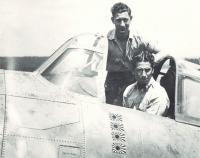
Phil Souza in his plane showing 4 Japanese flags representing 4 aerial victories.
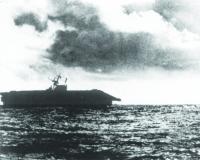
Hornet sinking.

Japanese planes prepare to take off from deck of Shokaku, Oct. 26, 1942.
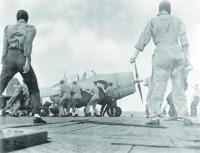
Wildcat fighter prepares to take off from the deck of the Enterprise, Oct. 24, 1942.
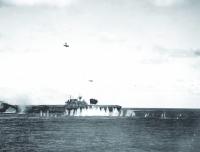
Damaged Japanese dive bomber dives on the USS Hornet while a Japanese torpedo plane flies over the U.S. carrier, Oct. 26, 1942.

Thomas C. Kinkaid

Chuichi Nagumo
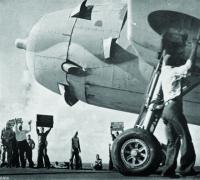
An Avenger torpedo plane prepares to take off from deck of Enterprise, Oct. 26, 1942.
Seventy years ago, the Battle of Santa Cruz Islands took place on October 25-26, 1942. The battle is sometimes referred to as the Battle of Santa Cruz, or in Japanese sources as the Battle of the South Pacific. This naval battle was the fourth carrier battle of the Pacific campaign of World War II and the fourth major naval engagement fought between the United States Navy and the Imperial Japanese Navy during the lengthy Guadalcanal campaign. In similar fashion to the battles of Coral Sea, Midway, and the Eastern Solomon Islands, the ships of the U.S. and the Imperial Japanese navies were rarely in direct visual range of each other. Instead, almost all attacks by both sides were mounted by carrier, or land-based, aircraft.
In an attempt to drive U.S. Marines from Guadalcanal and end the stalemate that had existed since September 1942, the Imperial Japanese Army planned a major ground offensive on Guadalcanal for October 20-25, 1942. In support of this offensive, and with the hope of engaging U.S. naval forces, Japanese carriers and warships moved into a position near the southern Solomon Islands. From this location, the Japanese naval forces hoped to engage and decisively defeat any U.S. naval forces, by sinking the last two remaining operational carriers in the Pacific - the USS Enterprise and the USS Hornet. These were the same carriers that launched Doolittle’s famous raid on Tokyo on April 19, 1942. U.S. naval forces in the South Pacific also hoped to meet the Japanese naval forces in battle, with the same objectives of breaking the stalemate and decisively defeating the Imperial Japanese Navy Combined Fleet.
In command of the Japanese naval forces was Vice Admiral Chuichi Nagumo, the man who commanded the Japanese Naval forces at Pearl Harbor and Midway. His objective was to seek and draw U.S. naval forces into battle. To accomplish this task two Japanese fleet carriers, Hiy and Juny, and one light carrier, Zuih, arrived at the main Japanese naval base at Truk, from Japan, in early October. Shortly after their arrival at Truk, the carriers Juny, and Zuih sailed to join the carriers Shokaku and Zuikaku, the two remaining fleet carriers from the attack on Pearl Harbor.
With four carriers fully equipped with air groups, and four battleships, eight heavy and two light cruisers, thirty destroyers, twelve submarines, and four oil tankers, the Japanese Combined Fleet, directed by Admiral Isoroku Yamamoto from the battleship Yamato, in Truk, was confident that they could make up for their defeat at the Battle of Midway. Apart from a couple of air raids on Henderson Field in October, the Japanese carriers and their supporting warships stayed out of the battle for Guadalcanal, in the northwestern area of the southern Solomon Islands, waiting for a chance to approach and engage the U.S. carriers.
With the Japanese Army's next planned major ground attack on the U.S. forces on Guadalcanal set for October 20, Nagumo's warships began to position themselves toward the southern Solomon Islands to support the army offensive on Guadalcanal, and to be ready to engage any U.S. warships, especially the carriers, that were assembled to support the U.S. defenses on Guadalcanal. The Japanese believed that U.S. Navy forces were likely to be in the Solomon Island area because they had read a report from United Press dated October 20 that stated that the United States Navy was preparing for a major sea and air battle in the South Pacific.
On the American side, the forces assembled to oppose the Japanese move were under Vice-Admiral William Halsey who replaced Vice-Admiral Robert Lee Ghormley as commander of South Pacific Forces. The forces were grouped into two naval task forces - Task Force 16, under Rear Admiral Thomas Kinkaid, and Task Force 17, under Rear Admiral George Murray. Task Force 16 was composed of the carrier USS Enterprise, the battleship USS South Dakota, one heavy and one light cruiser, and eight destroyers. Task Force 17 included the carrier USS Hornet, two heavy and two light cruisers, and six destroyers.
The battle of Santa Cruz Islands commenced on October 25 when a Catalina flying boat reported sighting two Japanese carriers 360 miles WNW from Vice Admiral Kinkaid’s Task Force 16 and they were moving SES. Kinkaid immediately ordered a search pattern to be conducted followed by a strike against the two Japanese carriers. As a result the Japanese light carrier Zuih was damaged and had to retreat to Truk after launching all her planes. The Japanese, realizing that they were under full attack by planes from the Hornet and Enterprise, and knowing that the Hornet was the same carrier that launched the B-25 bombers against Tokyo, decided to focus their attention on the Hornet.
October 26 saw both sides launching air strikes, and U.S. Navy and Japanese fighters engaged in combat to shoot down their opponent’s torpedo and dive bombers. In a battle of vicious attacks from both sides, the Japanese sunk the Hornet and a destroyer, and damaged the Enterprise and the battleship South Dakota. U.S. Navy planes succeeded in damaging two Japanese carriers (the Zuiho and the Shokaku) as well as two destroyers. More importantly the U.S. held the advantage in one specific statistic. The U.S. Navy had lost 74 aircraft, while destroying 92 Japanese. It was a loss that the Japanese Combined Fleet could not afford. The battle for Guadalcanal was proving to be very costly for both sides.
Though, tactically, the Battle of Santa Cruz Islands gave the Japanese a slight advantage, strategically it was a narrow victory for the Americans. Nagumo's carriers and battleships had been turned away from Guadalcanal, giving the Marines there some much needed relief. Perhaps more important, the destruction of the best Japanese naval aircrews, begun in earnest at Midway, culminated at Santa Cruz. Though plane losses were high on both sides - 74 American and 92 Japanese - the loss of airmen pointed to a Japanese catastrophe. Nearly 70 Japanese aircrews - including a number of squadron leaders - never returned to their carriers at Santa Cruz, while all but 33 American airmen did.
The Imperial Japanese Army's failure to capture Henderson Field, and the destruction of so many fine planes and pilots, all combined to make the outcome of Santa Cruz a critical strategic defeat for the Japanese. The Americans were still stubbornly tied to the airfield, and Enterprise, though considerably damaged, was still a potent weapon. However, for the next few weeks the U.S. Navy would be without operable carriers in the Pacific. The Lexington, Yorktown, Wasp, and Hornet had been sunk, while the Saratoga was under repair after suffering a torpedo hit from a Japanese submarine. And the Enterprise would be out of action due to the damage sustained at Santa Cruz.
The Battle of Santa Cruz Islands would have a far reaching effect on both navies. For the U.S. Navy, more time was needed to absorb the new carriers coming out of the shipyards in large numbers - Essex class fleet carriers, Independence class light carriers, and the escort carriers. As for the Imperial Japanese Navy, the task of training new air crews and flight leaders to replace the ones that were lost at Midway and Santa Cruz, would prove to be almost an impossible task. It would take another 20 months before the two navies would face each other again with carriers at the Battle of the Philippine Sea in June 1944.
Commander Phil Souza II, a retired naval aviator who lives in Ridgecrest, California, and a friend of mine, supplied me with many references, including the best written book on the subject – "Guadalcanal Campaign, Naval Fighter Combat from August to November 1942" by John B. Lundstrom. Many of the accounts in the book were based on communications between the author and the father of Cmdr. Souza. His father, Ensign Phil Souza served on the carrier Hornet during the Battle of Santa Cruz in a VF-72 Flying Wildcat fighter plane. By the end of the battle he had shot down four Japanese planes. Phil Souza would return to the United States as a true naval hero, earning the Distinguished Flying Cross and five air medals. He also had six confirmed kills to his credit making him a naval "Ace." Phil Souza continued serving his country well into the Korean War, where he was the C. O. of fighter reconnaissance squadron VC-61 flying F9F Panther, and Banshee jets. After many years of distinguished service in the U.S. Navy, he retired as commander in 1965.
NEXT WEEK: EL ALAMEIN
«Go back to the previous page.







